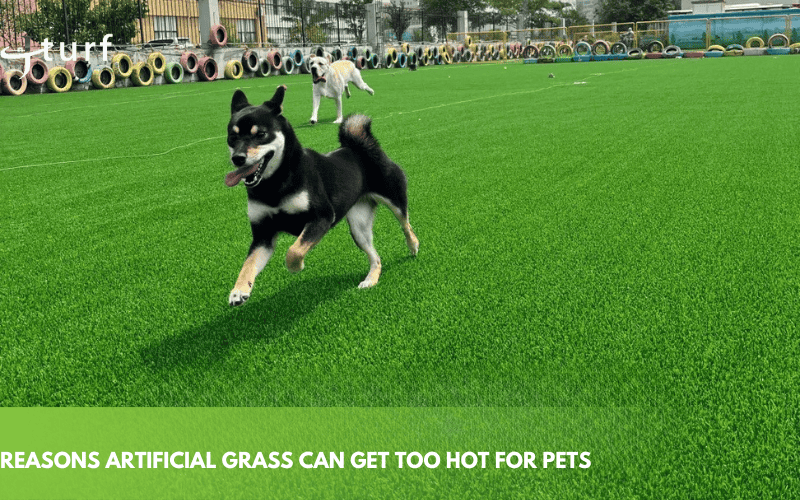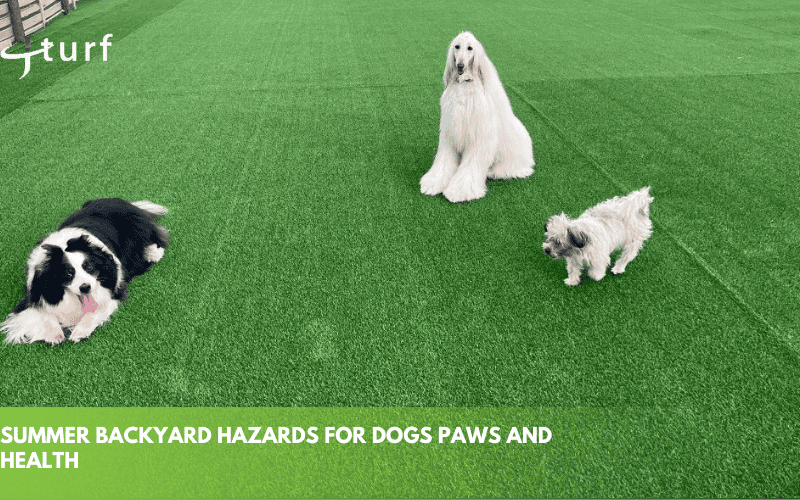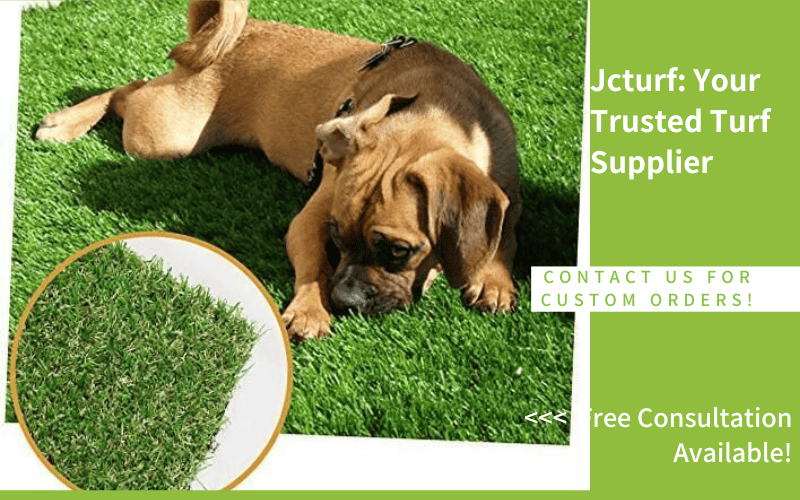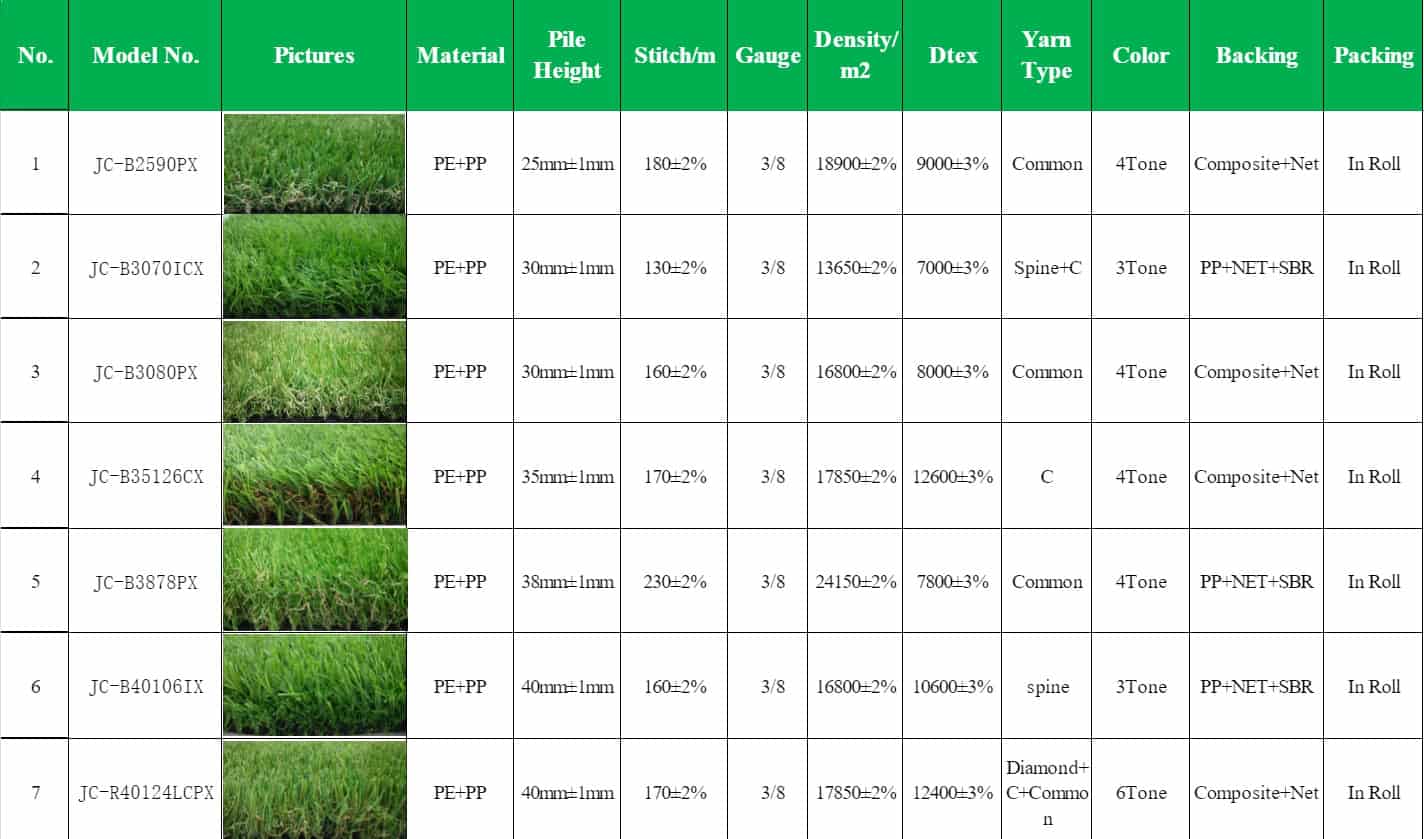Yes—artificial grass can get hot in the summer. And yes, it can be too hot for your dog’s paws—if you choose the wrong type or don’t plan for heat.
But that doesn’t mean you have to give up on it.
The problem isn’t the grass—it’s what you know about it.
In this article, we’ll explain how artificial turf can burn your dog’s paws, how its temperature compares to natural grass, and what specific factors—like material, color, and infill—make some turf hotter than others. You’ll also learn practical ways to keep turf cooler and safer, how to identify pet-friendly turf, whether artificial grass is the right choice for dog owners, and what other hot-weather hazards may be hiding in your backyard.
Because in your dog’s world, your backyard is more than a space—it’s a playground, a nap zone, and a place they trust. Let’s make it worthy of that trust.
Can Artificial Grass Burn Your Dog’s Paws?
Yes, artificial grass can get hot enough to burn your dog’s paws—especially during summer. On sunny days, turf temperatures can quickly rise beyond safe levels. Once the surface reaches 120°F (49°C), it may cause discomfort. At 130°F (54°C) or higher, the risk of actual paw pad burns increases significantly, particularly with prolonged contact.
Unlike human skin, a dog’s paw pads are tougher but not immune to heat damage. Burns may occur silently, and dogs often don’t show immediate signs of pain. You might only notice symptoms hours later, such as limping or excessive licking.
Watch for these warning signs after your dog has spent time on artificial turf:
- Hesitation or refusal to walk on the grass
- Frequent licking or chewing of feet
- Red, darkened, or swollen paw pads
- Whining, limping, or favoring certain paws
The risk is highest on clear summer days when the turf is dark in color, there is minimal shade, and no cooling measures like misting or watering are in place. However, this doesn’t mean you must avoid artificial grass entirely—it simply requires awareness of heat conditions and proactive steps to protect your dog.
How Hot Can Artificial Grass Get Compared to Natural Grass?
Artificial grass can become 40 to 70°F (22 to 39°C) hotter than natural grass on sunny days. When the air temperature is around 90–100°F (32–38°C), turf surfaces can reach 130 to 160°F (54–71°C)—hot enough to cause discomfort or burns. In contrast, natural grass typically stays below 90°F (32°C) under the same conditions.
This temperature gap exists because synthetic turf lacks natural cooling mechanisms like moisture retention and airflow. Materials such as polyethylene or nylon absorb and retain solar heat, especially when the turf is dark-colored or has rubber infill. Conversely, light-colored turf with cooling infill can stay noticeably cooler.
While artificial grass heats up faster, the good news is that surface temperature can be managed with shade, watering, or selecting heat-reflective turf materials.
What Makes Some Artificial Grass Too Hot for Pets?
Some artificial grass can get too hot for pets—depending not just on the weather, but also on what the turf is made of and how it’s installed. Factors like turf material, color, density, infill type, and site conditions all influence surface temperature. Understanding these elements can help you choose safer, cooler options for your pets.

Turf Fiber Material
The material used in the grass blades plays a big role. Polyethylene is the most common type for pet turf because it stays cooler than alternatives like nylon. Nylon is extremely durable, but it tends to hold more heat, which can be uncomfortable for pets on hot days.
Color and Shade
Just like clothing or pavement, darker colors absorb more sunlight. Artificial grass with deep green or dark olive tones heats up faster than lighter or more muted greens. Some manufacturers now offer turf in slightly cooler shades designed to reflect more sunlight.
Turf Density and Pile Height
Turf that’s very dense or has long blades may trap more heat. It can reduce airflow and create a layer of stagnant hot air near the surface. On the other hand, turf with a breathable, open design allows better circulation and tends to cool faster.
Infill Type
Infill—the material brushed into the base of the turf—has a major impact on heat. Traditional rubber crumb infill absorbs and radiates heat, which can raise surface temperatures dramatically. Newer cooling infills, made from silica sand or coated minerals, help reflect heat and stay cooler to the touch.
Installation and Site Conditions
Even the best turf can get hot if it’s installed in a full-sun area without any shade or ventilation. Backyard layouts, nearby hardscapes, and how much direct sun the turf gets throughout the day all affect heat retention. Shade from trees, walls, or canopies can make a big difference.
Putting It All Together
When you see a backyard turf that feels too hot, chances are one or more of these factors are at play. Understanding the variables helps you make better choices—not just for comfort, but for your dog’s safety too.
How to Keep Artificial Grass Cool and Safe for Dogs
Keeping artificial grass cool and safe for dogs is achievable with a few practical strategies. From choosing cooling infill and adding shade, to using misting techniques, selecting pet-friendly turf, and testing surface temperature—these small actions can make a big difference in hot weather.
Choose Cooling Infill from the Start
If you’re still planning your turf installation, this is where you can make the biggest difference. Cooling infill materials—like coated sand or evaporative minerals—are designed to reflect heat and lower surface temperatures. Unlike rubber crumb, they don’t store heat and often feel cooler underfoot, even in full sun.
Create Shade Where You Can
Direct sun is the biggest factor in turf heat. Shading part of your yard with trees, pergolas, shade sails, or even patio umbrellas can lower the surface temperature significantly. It doesn’t need to cover the entire area—just offering a shaded retreat can give your dog a safe, cool place to rest.
Rinse or Mist During the Hottest Hours
Watering turf might seem counterintuitive, but a quick rinse with a hose or a light misting system can rapidly bring down the temperature. Many pet owners keep a garden sprayer nearby and lightly spray the turf before letting their dog out during peak sun hours.
Use Turf That’s Designed for Pets
Some artificial turf is built with heat management in mind. Look for pet-friendly products with lighter colors, breathable backing, and heat-resistant fibers. These features may not eliminate heat completely, but they help reduce the extremes.
Test Before Letting Your Dog Out
If the sun’s been out for a while, it’s a good habit to check the turf before letting your dog walk on it. Place your hand or bare foot on the surface for a few seconds. If it’s too hot for you, it’s probably too hot for your dog.
Keeping turf comfortable in summer isn’t complicated—it’s about combining smart product choices with simple, low-effort routines.
What Is Pet-Friendly Artificial Turf and Why Is It Different?
Pet-friendly artificial turf is specifically designed to meet the needs of dogs. Unlike standard turf made for landscaping or aesthetics, it prioritizes comfort, hygiene, and safety for animals.
The fibers used in pet turf are typically softer and cooler, often made from polyethylene rather than stiffer materials like nylon. Blade height is usually shorter, and the spacing allows for better airflow and faster surface cooling.
Effective drainage is essential. Pet turf uses perforated or flow-through backing to prevent urine from pooling and reduce odor buildup. This structure also helps release moisture and heat more efficiently.
The infill in pet turf is selected with pets in mind—it’s less abrasive, stays cooler, and discourages bacterial growth. Lighter turf colors are also common to reflect sunlight and maintain a lower surface temperature.
When evaluating turf for pets, ask whether it was designed for animal use, what materials and infill it includes, and whether it offers odor control or cooling features. Choosing the right product upfront ensures a safer, more comfortable environment for your dog.
Should You Avoid Artificial Grass If You Have Dogs?
It’s a fair question—and it’s one many pet owners ask. If artificial turf can get hot, and there’s a risk of paw burns, wouldn’t it be safer to just stick with natural grass?
The short answer: not necessarily.
While natural grass stays cooler underfoot, it comes with its own set of challenges. Mud, pests, brown spots, and chemical treatments are just a few. For dogs with allergies or sensitive paws, a well-designed artificial turf setup may actually be the healthier option.
The key is to understand that not all turf is created equal, and heat isn’t an unsolvable problem. With the right turf type, proper infill, good drainage, and a bit of shade, artificial grass can be just as pet-friendly as it is low-maintenance.
What really matters is how you plan and use it. If you install the right product and stay aware of hot-weather conditions, your dog can enjoy the space comfortably—without you having to worry about muddy paws or burned grass patches.
So no, you don’t have to avoid artificial grass just because you have pets. You just need to choose the right version of it—with your dog’s safety and comfort in mind.
Other Summer Hazards for Dogs in the Backyard

Artificial turf isn’t the only thing that gets hot in summer. In fact, many common backyard surfaces can pose equal—or greater—risks to your dog’s paws and health.
You might not realize it, but concrete patios, stone paths, wooden decks, and even metal fixtures can reach extreme temperatures under direct sun. Some of these materials heat up faster than turf and retain heat longer. Unlike artificial grass, they often don’t come with cooling options.
Gravel can be another issue. Small rocks can become hot and uncomfortable to walk on, especially for older dogs. Plus, sharp edges can irritate or cut sensitive paw pads.
Heat isn’t just a surface problem. Dogs can suffer from dehydration and heatstroke quickly, especially if there’s no shaded area or cool water available. Knowing the signs—like excessive panting, drooling, or lethargy—can help you respond before things get serious.
In comparison, a well-maintained turf space with shade and cooling features can actually reduce some of these risks. No mud, no pesticides, and no sharp textures—just a clean, consistent surface your dog can enjoy.
As with anything outdoors in summer, awareness is key. Whether you use artificial grass or not, building a backyard environment with your dog’s comfort in mind makes all the difference.
Conclusion
Asking whether artificial grass is too hot for your dog isn’t just a product question. It’s a reflection of something deeper: your care, your awareness, and your commitment to creating a safe, happy space—for someone who can’t speak for themselves, but trusts you completely.
Yes, turf can heat up. But as you’ve seen, the real difference comes down to knowledge and intention. The right material, the right design, and a little awareness go a long way. What was once a concern becomes a solved problem. What felt risky becomes manageable—and even beneficial.
By thinking ahead, you’re not just protecting your dog’s paws.
You’re protecting their freedom to run, nap, roll, and just be a dog—without worry.
And that matters.
Ready to Choose Pet-Friendly Turf That’s Built for Safety?
At the end of the day, your dog deserves more than just a patch of green—they deserve a surface that’s safe, cool, and made with their needs in mind. As a professional pet turf manufacturer, we design and supply high-quality artificial grass that puts pets first—from heat-resistant fibers to hygienic, easy-drain systems.
Explore our Pet-friendly Turf and discover how you can upgrade your backyard into a paw-friendly paradise — featuring cooler surfaces, odor-free drainage, and pet-safe durability you can trust.
Whether you’re a distributor, wholesaler, or planning a custom installation, we’re here to help you find the right product for every pup.
Protect the paws. Preserve the play. Partner with a turf manufacturer that truly gets pets.



